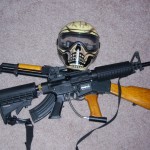
With summer just around the corner, many people are exploring their options for activities. As there are many sports out there, there is the benefit of many choices to choose from. If you are leaning more towards a fast paced, adrenaline building, strategy based type of activity, then scenario paintball might be a suitable alternative.
Generally played in large forest areas or on a sponsored field such as Tactical Paintball in Harwood, TX, the sport of Scenario-ball is very different from Speed-ball, which is played with small teams in bright uniforms with fast guns. Woods-ball, another playing exercise, is just like Speed-ball but in the woods. Scenario-ball teams vary in numbers, because several teams will have different squads and battalions until an army on both sides of the area is created. Both sides usually have an average of about 150 people each, and if the hundreds of people weren’t intimidating enough, then the rocket launchers, tanks, grenades and a wide array of weapons will. Needless to say, this sport is not recommended for people who are new to paintball or who do not have much experience on the field.
Getting in shape for this sport is not only recommended; it’s absolutely necessary. Players must be able run for extended periods of time and must keep their reflexes up as well as be able to keep all their gear comfortably. Workouts that help achieve these goals include push-ups, timed runs, a little bit of weight lifting and team-building exercises like team wall climbs and Indian runs. For the people that want to step up their workouts, try doing these exercises in the full gear that you would wear for paintball.
Each person on the team has a specific job on the team that they are responsible for carrying out.
Commander: The commander of the team is the most skilled player, often with the most experience. He or she is also responsible for making all the strategies that they expect their team to follow out in order to ensure their success. The commander at times has another position that they play when the team requires an experienced player on the field.
Light Rifleman: Light rifleman are the first team sent out when the game begins. They often have standard equipment that is for the most part basic.
Heavy Rifleman: These players have some experience under their belts. Heavy rifleman, or heavy gunners as they are more commonly called, have better equipment and are usually fitted with a sidearm to insure they stay in the fight. If you’re relatively new to Scenario-ball, stick with a heavy gunner, they know what they’re doing.
Sniper: This position is pretty self explanatory. The sniper is the person on the team that is best trained in stealth, and is also generally the best shot on the team. He is not exactly a position for someone who likes immediate action, or has an itchy trigger finger, but should be cool and collected. Camouflage is a must for this position.
Spotter: The spotter’s job is to basically be the snipers right-hand man. Spotters typically carry equipment that is highly customizable. The reason for this is because snipers have the job of long-distance shooting and are virtually helpless if they are attacked by an ambush. Therefore, spotters should be well equipped for both CQC (close-quarters-combat), and MRC (mid-range-combat). Spotters should also carry binoculars in order to scout targets for the sniper, hence the name of the position.
Tank Hunter: Tank hunters get the fun and sometimes difficult job of going out on the field and acting on call when an enemy tank is spotted (Yes, some competitions have manned tanks and armored vehicles on the field). Standard equipment requirements follow with one exception: tank hunters should be fitted with several grenades as well as a rocket launcher if available.
Recon: Recon are the first people on the team sent out onto the field. This is because when the event is just beginning, there will be less action and more time for recon to scout the area looking for possible weak spots or strong spots in the enemies’ defenses.
Support: Often called “The Cavalry”, support players are equipped with the heaviest, strongest, most intimidating weapons, their job is to respond to players that are becoming overwhelmed with enemies. If you’re ever in a jam or start a fight you can’t finish, call “The Cavalry”.
Medic: Medics are just that, medics. Like all scenario forces, they own a communications radio and respond to calls of players that have been wounded but not fatally. The medics carry medical equipment and standard weaponry.
Specialty: Specialty players have a certain task that they are responsible for carrying out. They are not always on the field, only when they are needed for their task. Not every team needs a specialty player or squad, but the few that do have their specialty players equipped with the best gear in every category. For example, team BLK FACTIONs specialty squad is called S.T.A.B.S. (Stealth Trained Assassination Battle Squad). STABS consists of four members, these four are trained to covertly take out the enemy general on the opposite side of the field.
So now that you know some basic workouts, player positions and the jobs of each, you are ready to take your knowledge of the sport a little further, and tune in next week for another addition to the “Scenario Paintball: Beginner’s Guide” series.








Thanks for publishing this article. I have been looking into paintball for a while and never really knew much, like good places where to go. This helped me a lot. Can’t wait until the next one.